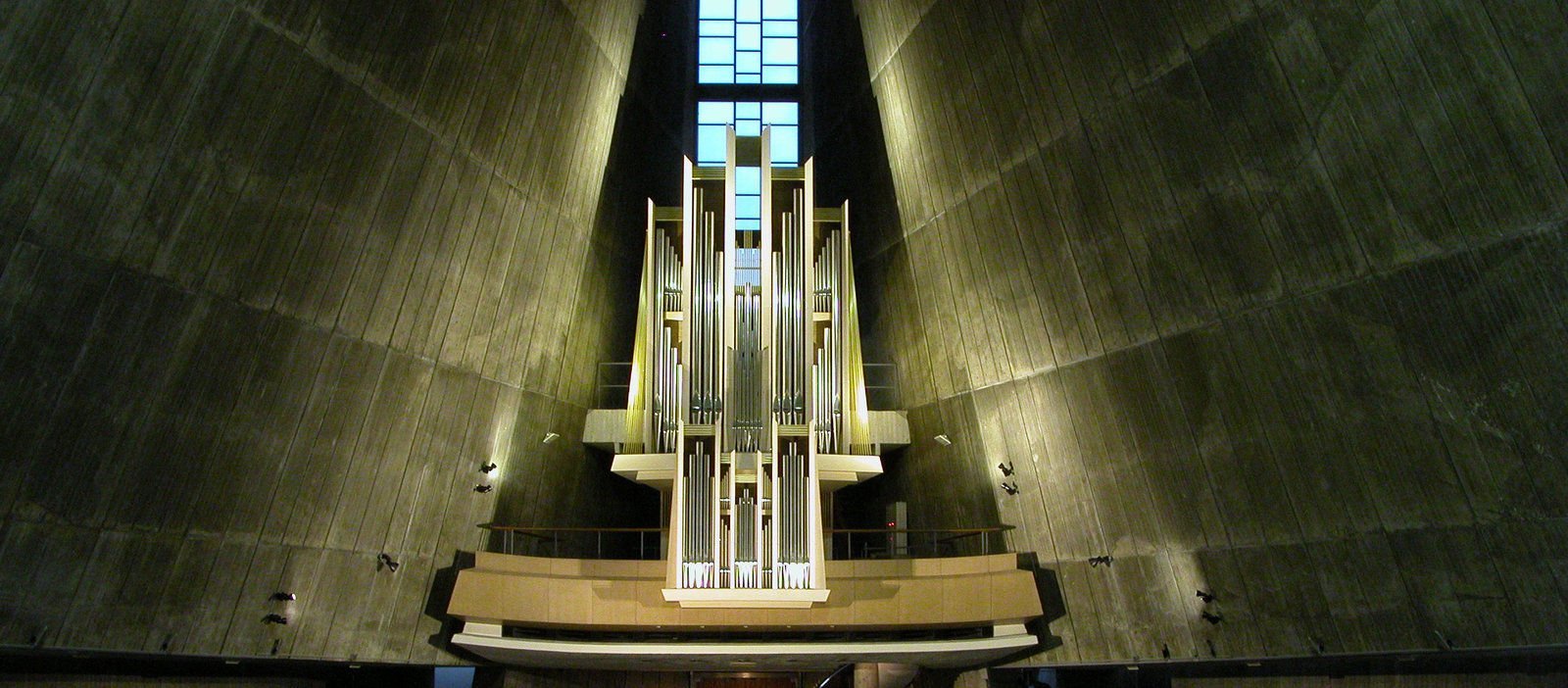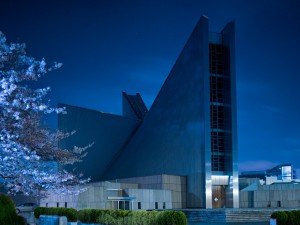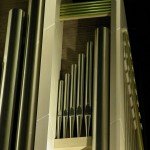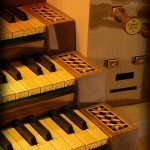TOKYO (Japan) – St. Mary’s Cathedral
THE CATHEDRAL by KENZO TANGE
Like many ancient Christian churches, this cathedral is built in the form of a cross. The arms of the cross measure 55.5 and 40 meters respectively. However, contrary to what is seen in the West, architect Tange depressed the cross raising each of the arms of the cross to a height of 39.4 m.
The plan layout is a diamond, the sides of which are joined to the vertices of the cross using 8 curves called hyperbolic paraboloids. The tendency of the architect to develop monumental buildings using concrete and steel structures with such curves is also present at the National Gymnasium for Tokyo Olympics of 1964, designed more or less at the same time as the cathedral. In fact this technique had been previously used by Le Corbusier in buildings such as the Legislative Assembly of Chandigarh .
To this sculptural structure wrapped in stainless steel, which symbolizes the “light of Christ shining upon the world and the hearts of men”, the architect added other small cubic volumes, such as the baptistery.
Access to the lateral nave is reached by one of these added volumes. In fact you might think of it as a transitional space between the profane and the sacred, a kind of liminality, something which was also used by the Filipino master Leandro Locsin, a modern architect and a contemporary of Tange.
But while the exterior facade catches the eye due to its metal tones, especially glaring on a sunny day, the interior captivates with its grim tones and unfinished texture, just like the Japanese concept of wabi sabi , that is the aesthetic pleasure of unfinished things , also used in works by other architects, such as the famous Church of Light by Tadao Ando.
 The exposed concrete also symbolizes a biblical concept: “The Lord is my rock and my fortress in whom I take refuge …” ( Psalm 18:2 ). Hence, the architect wants to express strength and at the same time levitation through sculptural form.
The exposed concrete also symbolizes a biblical concept: “The Lord is my rock and my fortress in whom I take refuge …” ( Psalm 18:2 ). Hence, the architect wants to express strength and at the same time levitation through sculptural form.
These concrete walls provide a dramatic spectacle in their contact with light, which seeps through the studied openings located in the zenith, or through the elongated windows on the sides of the cross (the reader can find a similar use of light in the Cathedral of Los Angeles by Rafael Moneo).
The biggest attraction of the church is the space, modeled, sculptured and monumental. In some occasions, a light and musical show is featured, providing the visitor with a mystical and theatrical experience.
THE ORGAN
Tokyo cathedral is a monument of our time, built in the early 60s as per the vision of the architect Kenzo Tange.
The organ is a worthy completion of its interior. Located on the balcony above the main entrance, it is one of the few instruments in Japan on which a broad repertoire of organ music is playable, but in a context outside the concert hall. Hence it remains sacred and spiritual.
The sounds are clear and transparent, designed to resonate in the large acoustics of the church. The instrument, too, reflects time-proven organ building traditions but is yet modern and flexible, conceived for both liturgy and concert use.
Special care was taken in the design and voicing of the traditionally Italian stops. Those on the ‘Positive’, for example, are based on pipe-scales by Antegnati. And despite the instrument’s dimensions, the key-action remains light, allowing absolute control at all times.
The slightly unequal temperament (5 pure fifths, 5 fifths 1/6 of a comma narrow, 2 fifths 1/12 of a comma narrow) gives beauty and colour to the overall sound, yet allowing the use in all keys.
DISPOSITION
3 keyboards 58 keys (C-a) – pedalboard 30 keys (C-f)
| Manual I – Positivo tergale (Ruckpositiv) | ||
| 1. | Principale italiano (Antegnati) | 8′ |
| 2. | Ottava | 4′ |
| 3. | Decimaquinta | 2′ |
| 4. | Decimanona | 1.1/3′ |
| 5. | Flauto in VIII | 4′ |
| 6. | Voce Umana (dal C3) | 8′ |
| 7. | Bordone | 8′ |
| 8. | Principale | 4′ |
| 9. | Sesquialtera 2 file | 2.2/3′-1.3/5′ |
| 10. | Ripeno 3 file | 2′ |
| 11. | Cromorno | 8′ |
| Usignoli | ||
| Tremolo | ||
| Manual II – Great Organ | ||
| 12. | Principale | 16′ |
| 13. | Principale | 8′ |
| 14. | Ottava | 4′ |
| 15. | Quinta | 2.2/3′ |
| 16. | Ottava | 2′ |
| 17. | Mistura 5 file | 2′ |
| 18. | Cimbalo 3 file | 2/3′ |
| 19. | Flauto a camino | 8′ |
| 20. | Flauto a cuspide | 4′ |
| 21. | Nazardo | 2.2/3′ |
| 22. | Terza | 1.3/5′ |
| 23. | Tromba | 8′ |
| Manual III – Recitativo | ||
| 24. | Bordone | 16′ |
| 25. | Bordone | 8′ |
| 26. | Viola da Gamba | 8′ |
| 27. | Principale | 4′ |
| 28. | Flauto | 4′ |
| 29. | Flauto | 2′ |
| 30. | Cornetto 3/5 file | 8′ |
| 31. | Ripieno 4 file | 2′ |
| 32. | Dulziana | 16′ |
| 33. | Tromba | 8′ |
| 34. | Oboe | 8′ |
| 35. | Clarone | 4′ |
| Tremolo | ||
| Pedal | ||
| 36. | Subbasso | 32′ |
| 37. | Contrabasso | 16′ |
| 38. | Violone | 16′ |
| 39. | Subbasso (trasmesso dal 24) | 16′ |
| 40. | Basso | 8′ |
| 41. | Bordone (trasmesso dal 25) | 8′ |
| 42. | Mistura 4 file | 2.2/3′ |
| 43. | Tromboni | 16′ |
| 44. | Tromba (trasmesso dal 33) | 8′ |
| 45. | Tromba (trasmesso dal 35) | 4′ |
| 46. | Tromba | 8′ |
| Couplers | ||
| 1. | III – II | |
| 2. | I – II | |
| 3. | III – Pedal | |
| 4. | II – Pedal |
THE ARTISTIC CONSULTANT
The Italian organist and harpsichordist, Lorenzo Ghielmi, is organist at the Ahrend organ (1991) at the Basilica of San Simpliciano in Milan, where he performed, from 1992 to 1994, the complete organ works of J.S. Bach. He gives concerts throughout Europe, Japan and the USA as organist and harpsichordist. He has made many radio and CD recordings (including for Teldec, Deutsche Harmonia Mundi, Ars Musici, and Winter & Winter). He plays with his instrumental ensemble La Divina Armonia and in duet with his younger brother Vittorio Ghielmi (viola da gamba and harpsichord). In France, he received the Diapason d’Or for his recordings of Bruhns and Bach. He also played organ & harpsichord in the first recordings of Il Giardino Armonico.
Lorenzo Ghielmi, teaches organ, harpsichord and early music at the Milan Accademia Internazionale della Musica. He also taught for several years as visiting professor in Trossingen and at the Hoschule für Musik in Lübeck. He is often invited to sit on juries for international organ competitions (Toulouse, Tokyo, Bruges, Freiberg, Maastricht, Lausanne, Nuremberg, Landsberg, Chartres). He also gives lectures and master-classes in many musical institutions, including the prestigious Haarlem’s Summer-Academy. He was the main artistic consultant for the new Mascioni organ constructed at Tokyo cathedral.
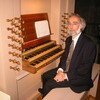 Lorenzo Ghielmi combines his concert activities with a passion for musicological research. He has published editions of music by Girolamo Frescobaldi and composers from Milan, as well as studies on 16th and 17th century organ building, and on the interpretation of works of Bach. Recently he has written a book on Nicolaus Bruhns’s organ works.
Lorenzo Ghielmi combines his concert activities with a passion for musicological research. He has published editions of music by Girolamo Frescobaldi and composers from Milan, as well as studies on 16th and 17th century organ building, and on the interpretation of works of Bach. Recently he has written a book on Nicolaus Bruhns’s organ works.
MOVIE OF THE INSTALLATION
TESTIMONIALS
Dear Mr.Mascioni ,
my brother Ernst-Erich Stender is very enthusiastic about the wonderful Mascioni organ Opus 1165.
The Pipeorgan is magnificent! The sounds are transparent and clear – perfect for the large acustic of the Cathedral!
Wonderful is the Intonation of typical italian stops (Positiv).
What a lightness of the action and a perfekt control of the touch .It was a real pleasure to play in St. Mary `s Cathedral my brother said.
Prof. Stender was appointed to the position of organist at the St. Mary`s Church in Lübeck in 1973. In this famous church (Dietrich Buxtehude worked here from 1667 to 1707) he has performed 50 to 70 concerts each year with varying programmes.His repertoire has included the most significant works from the Baroque to modern times. Time and again he has interpreted the entire organ works by Johann Sebastian Bach and Dietrich Buxtehude.Numerous CD / DVD recordings (www.ornamentrecords.de) demonstrate his versatility. He has adapted numerous symphonies by Bruckner, Beethoven, Schubert , Dvor`ak for the organ and recorded them on CD. My brother would be very glad if there is a possibility to visit the FABBRICA D ` ORGANI MASCIONI in Azzio.
Hans – Dietrich Stender
Concerts Manager Täby ( Stockholm ) Sweden
E-mail : hans.stender @telia.com

